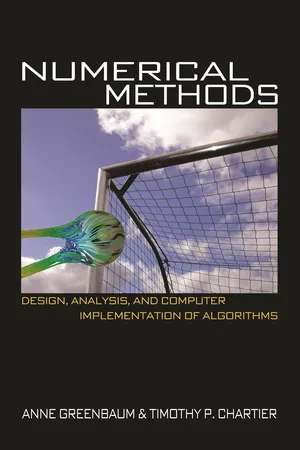
Numerical Methods
Design, Analysis, and Computer Implementation of Algorithms
- 464 pages
- English
- ePUB (mobile friendly)
- Available on iOS & Android
Numerical Methods
Design, Analysis, and Computer Implementation of Algorithms
About this book
A rigorous and comprehensive introduction to numerical analysis
Numerical Methods provides a clear and concise exploration of standard numerical analysis topics, as well as nontraditional ones, including mathematical modeling, Monte Carlo methods, Markov chains, and fractals. Filled with appealing examples that will motivate students, the textbook considers modern application areas, such as information retrieval and animation, and classical topics from physics and engineering. Exercises use MATLAB and promote understanding of computational results.
The book gives instructors the flexibility to emphasize different aspects—design, analysis, or computer implementation—of numerical algorithms, depending on the background and interests of students. Designed for upper-division undergraduates in mathematics or computer science classes, the textbook assumes that students have prior knowledge of linear algebra and calculus, although these topics are reviewed in the text. Short discussions of the history of numerical methods are interspersed throughout the chapters. The book also includes polynomial interpolation at Chebyshev points, use of the MATLAB package Chebfun, and a section on the fast Fourier transform. Supplementary materials are available online.
- Clear and concise exposition of standard numerical analysis topics
- Explores nontraditional topics, such as mathematical modeling and Monte Carlo methods
- Covers modern applications, including information retrieval and animation, and classical applications from physics and engineering
- Promotes understanding of computational results through MATLAB exercises
- Provides flexibility so instructors can emphasize mathematical or applied/computational aspects of numerical methods or a combination
- Includes recent results on polynomial interpolation at Chebyshev points and use of the MATLAB package Chebfun
- Short discussions of the history of numerical methods interspersed throughout
- Supplementary materials available online
Frequently asked questions
- Essential is ideal for learners and professionals who enjoy exploring a wide range of subjects. Access the Essential Library with 800,000+ trusted titles and best-sellers across business, personal growth, and the humanities. Includes unlimited reading time and Standard Read Aloud voice.
- Complete: Perfect for advanced learners and researchers needing full, unrestricted access. Unlock 1.4M+ books across hundreds of subjects, including academic and specialized titles. The Complete Plan also includes advanced features like Premium Read Aloud and Research Assistant.
Please note we cannot support devices running on iOS 13 and Android 7 or earlier. Learn more about using the app.
Information
1
MATHEMATICAL MODELING

1.1 MODELING IN COMPUTER ANIMATION
1.1.1 A Model Robe



Table of contents
- Cover
- Half title
- Title
- Copyright
- Dedication
- Contents
- Preface
- 1 Mathematical Modeling
- 2 Basic Operations with Matlab
- 3 Monte Carlo Methods
- 4 Solution of a Single Nonlinear Equation in One Unknown
- 5 Floating-Point Arithmetic
- 6 Conditioning of Problems; Stability of Algorithms
- 7 Direct Methods for Solving Linear Systems and Least Squares Problems
- 8 Polynomial and Piecewise Polynomial Interpolation
- 9 Numerical Differentiation and Richardson Extrapolation
- 10 Numerical Integration
- 11 Numerical Solution of the Initial Value Problem for Ordinary Differential Equations
- 12 More Numerical Linear Algebra: Eigenvalues and Iterative Methods for Solving Linear Systems
- 13 Numerical Solution of Two-Point Boundary Value Problems
- 14 Numerical Solution of Partial Differential Equations
- Appendix A Review of Linear Algebra
- Appendix B Taylor’s Theorem in Multidimensions
- References
- Index